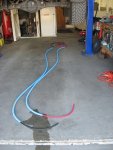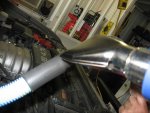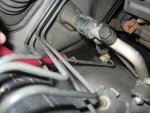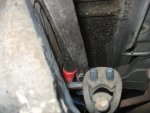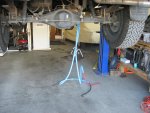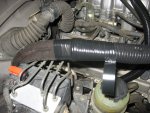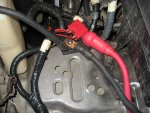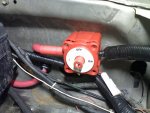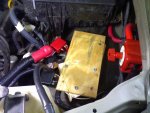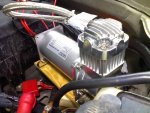RoundOut
Explorer
Battery Relocation Phase II - Cable routing
Wow, we got the hardest part started today. I have been concerned about routing the cable the safest way, since failure is not an option. We picked up some blue plastic conduit from Home Depot, along with some cool cable mounts. O'Rielly's had the coolest heat shrink I've ever used... it sort of reminded me of Mick Dundee, "That's not heat shrink, now this is heat shrink!" It starts out about an 1.25 - 1.5 inches in diameter and shrinks down to 3/8", with glue. We also employed two 3' lenghts of silicone starter cable protective cover from Smileys. Other materials used today included two 25' lengths of 2/0 battery cable, one in black and one in red, along with a few dozen zip ties.
Here's how it went...
Getting the cable into the conduit and into the silicone sleeve was interesting. We cut the 25' conduit in half to use some for each polarity of cable, and then put one end in the pipe holder of a bench vise. The stuff is pretty rigid, so we straightened it out and started feeding the black cable. We got the black cable into the conduit with brute force and twisting of the cable while holding the conduit fixed straight out. The red cable was not as easy. Finally I put some dish detergent in the conduit on the vise end and chased it with about a cup of water and allowed gravity to do its thing. I wish we had done this on the black, because it was a snap after that. We left about 18" of cable exposed on the box end of each cable. In the front, we pulled it back out and soaped up the silicone sleeve. We worked it on the cable slowly by sliding it together and then stretching it out, repeating this process until it was where we wanted it. After the sleeve was on, we used the red and black heat shrink from O'Reily's to seal up this joint tight. The funny part about using all the soap, was that when it dried, our hands picked up a ton of dirt, but later when we went to wash them off, they cleaned up without any additional soap. LOL
Next, we identified a route down the right side frame, just inside the rail from the battery box forward to just inside the wheelwell in the front right. I was concerned about heat near the headers, as the cables run within about 6" of them. We used the silicone ignition cable sleeves from this point down about 4" past the catalytic converters, where the blue plastic conduit picked up. I heat shrinked a water tight seal at this joint, after slitting the plastic conduit about 1/2" on the end to cover about 1/2" of silicone sleeve. The glue oozed out the end, so it looks like we got a great seal.
When it comes to cable routing, it sure helped having two of us. Starting from the front, we layed out the cable in front of the truck and fed it down behind the ABS controller, down the space closest to the corner of the firewall and rear of the right wheelwell, and over a cross-member, staying as far away from the exhaust as possible, and pulled the slack to the floor. With the truck lifted just about a foot, my buddy David got down on the crawler to pull from below while I fed from above. We then lifted the truck and after pulling all the cable down the rail in the most appropriate spots, we dropped the truck down again and fed it back about two feet more backwards, to allow me to easily add some split loom for the cable in the engine end and wrap it with electrical tape from the point where the silicone cover ended close to the other end. After wrapping it, we fed it back down to its desired location with the silicone protective sleeve in the areas closest to the headers and catalytic converter.
We had about an hour left before having to get cleaned up for dinner, so we zip tied the cable in place, leaving the rest for the next day, hopefully Saturday night. My son and I are headed to Huntsville State Park with some friends to do some mountain biking on the trails, and then have to be back to attend one of his buddies' Eagle Scout Court of Honor.
Here are some pics of today's efforts...
Wow, we got the hardest part started today. I have been concerned about routing the cable the safest way, since failure is not an option. We picked up some blue plastic conduit from Home Depot, along with some cool cable mounts. O'Rielly's had the coolest heat shrink I've ever used... it sort of reminded me of Mick Dundee, "That's not heat shrink, now this is heat shrink!" It starts out about an 1.25 - 1.5 inches in diameter and shrinks down to 3/8", with glue. We also employed two 3' lenghts of silicone starter cable protective cover from Smileys. Other materials used today included two 25' lengths of 2/0 battery cable, one in black and one in red, along with a few dozen zip ties.
Here's how it went...
Getting the cable into the conduit and into the silicone sleeve was interesting. We cut the 25' conduit in half to use some for each polarity of cable, and then put one end in the pipe holder of a bench vise. The stuff is pretty rigid, so we straightened it out and started feeding the black cable. We got the black cable into the conduit with brute force and twisting of the cable while holding the conduit fixed straight out. The red cable was not as easy. Finally I put some dish detergent in the conduit on the vise end and chased it with about a cup of water and allowed gravity to do its thing. I wish we had done this on the black, because it was a snap after that. We left about 18" of cable exposed on the box end of each cable. In the front, we pulled it back out and soaped up the silicone sleeve. We worked it on the cable slowly by sliding it together and then stretching it out, repeating this process until it was where we wanted it. After the sleeve was on, we used the red and black heat shrink from O'Reily's to seal up this joint tight. The funny part about using all the soap, was that when it dried, our hands picked up a ton of dirt, but later when we went to wash them off, they cleaned up without any additional soap. LOL
Next, we identified a route down the right side frame, just inside the rail from the battery box forward to just inside the wheelwell in the front right. I was concerned about heat near the headers, as the cables run within about 6" of them. We used the silicone ignition cable sleeves from this point down about 4" past the catalytic converters, where the blue plastic conduit picked up. I heat shrinked a water tight seal at this joint, after slitting the plastic conduit about 1/2" on the end to cover about 1/2" of silicone sleeve. The glue oozed out the end, so it looks like we got a great seal.
When it comes to cable routing, it sure helped having two of us. Starting from the front, we layed out the cable in front of the truck and fed it down behind the ABS controller, down the space closest to the corner of the firewall and rear of the right wheelwell, and over a cross-member, staying as far away from the exhaust as possible, and pulled the slack to the floor. With the truck lifted just about a foot, my buddy David got down on the crawler to pull from below while I fed from above. We then lifted the truck and after pulling all the cable down the rail in the most appropriate spots, we dropped the truck down again and fed it back about two feet more backwards, to allow me to easily add some split loom for the cable in the engine end and wrap it with electrical tape from the point where the silicone cover ended close to the other end. After wrapping it, we fed it back down to its desired location with the silicone protective sleeve in the areas closest to the headers and catalytic converter.
We had about an hour left before having to get cleaned up for dinner, so we zip tied the cable in place, leaving the rest for the next day, hopefully Saturday night. My son and I are headed to Huntsville State Park with some friends to do some mountain biking on the trails, and then have to be back to attend one of his buddies' Eagle Scout Court of Honor.
Here are some pics of today's efforts...
- The cable layed out on the floor after putting it into the blue conduit. Note the soapy water oozing from the red cable.
- Getting ready to put the silicone sleeve on the red cable.
- Heat shrinking the joint between the plastic conduit and the silicone sleeve.
- The heat gun is the right tool for this job!
- Feeding cable down the route in the corner of the engine bay near the ABS controller.
- View from below, just behind the engine on the right frame rail as we fed the cable.
- Cable route near the catalytic converter. Don't worry, we zip tied these to the frame as far from the catalytic converter as possible. Also, this blue conduit is much farther back and the silicone sleeve protects it here after the final pull of cable.
Attachments
Last edited:

